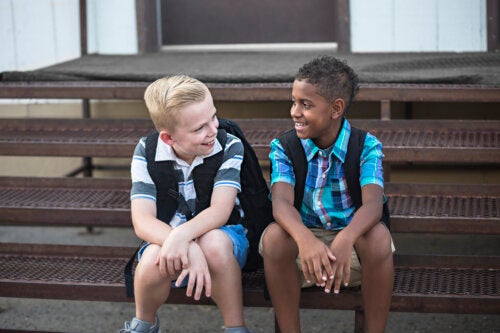How to Teach Assertiveness to Children

Childhood is a time of learning. It’s the time when literacy takes place and various academic skills are acquired. But beyond this, these years are crucial for the development of social skills and certain attitudes and tools that enable coexistence. Therefore, if we want them to relate in different areas and establish healthy relationships with their peers, it’s important to teach assertiveness to children.
This skill is of great importance as it’s closely related to the vision a person has of themself and others. Being assertive implies, firstly, knowing one’s own value and exercising self-respect; and secondly, addressing others with consideration and tolerance. It may seem complicated to transmit these ideas to children. However, there are a number of guidelines and actions that can help.
Why teach assertiveness to children?
Assertiveness is the ability to communicate opinions, desires, and needs firmly, appropriately, and with respect for the opinions and needs of others. It is, therefore, a social skill that allows children to express themselves clearly and honestly without hurting the other person.
This communication style is halfway between passivity and aggressiveness, so it’s a healthy and positive balance. When a child’s very passive, they may have difficulty setting limits, be easily influenced, and adopt submissive attitudes. On the contrary, if they’re very aggressive, they’ll harm others with their words and be inconsiderate or selfish and unable to negotiate.
These two styles are closely related to internalizing problems in childhood, such as anxiety, depression, or somatic complaints; and externalizing ones, such as disobedience, tantrums, or impulsivity.

How to teach assertiveness to children
Assertiveness is taught on a daily basis, with the style of parenting and the dynamics that are established at home and in the family. It’s not an innate skill but has to be learned. Fortunately, once acquired, it becomes part of the behavioral repertoire of the child, who’ll use it in the future. If you want to facilitate this learning process, take into account the following ideas.
Be an example of assertiveness
Parents are the main model that children look to in order to know how to behave and address others. Therefore, take care of the way you relate to your child: Do you speak to them with respect, do you take their opinions into account, do you know how to set limits, are you able to express how you feel and what you need so that they can understand you better?
Many times, adults limit themselves to giving orders and directing their little ones. However, this is the opposite of assertiveness. In the same way, try to be assertive with your partner, with your family, and with your friends. Your child also observes how you relate to other adults and learns from it.
Allow your children to express themselves
The home is the ideal environment for children to learn to express themselves in a safe environment. So, ask their opinion on everyday issues, allow them to make certain decisions, and take their preferences and needs into account. Also, encourage them to share what they think and feel and respect them when they say “no”. If they grow up in a family where they’re listened to and taken into account, it’ll be easier for them to make their voices heard and set their limits with others.
Teach them to negotiate
However, teaching assertiveness to children isn’t always giving in to their wishes. On the contrary, it’s helping them find that balance between themselves and others. For this, it’s essential to know how to give in, negotiate with others, be aware of other people’s points of view, and seek the common good in different situations. Everyday moments such as choosing a movie to watch as a family, where to go for dinner, or sharing toys with their siblings are perfect occasions to practice.

Explain communication styles
It can be very useful to talk to children about the different communication styles (passive, aggressive, and assertive) and give examples. In this way, they’ll know how to identify them and will be able to see when they’re assertive and when they’re not. In this regard, you can present them with situations and ask them what type of communication is used in each of them. Also, use stories or movies to detect these ways of exchanging messages.
Offers practical tools to teach assertiveness to children
Finally, although assertiveness can be seen in many ways, there are several techniques that can help to apply it. Here are some examples:
- Speaking from the “I”. Instead of saying “you hurt me,” you can say “I was hurt.”
- The broken record technique. This consists of repeating a statement (for example: “I don’t feel like it, thank you”) as many times as the other person insists.
- The assertive question technique. This involves taking a criticism, complaint, or claim made by another person in a positive way and asking them to help you improve. For example, if a classmate complains to your child that they’re not playing a game well, instead of getting offended and arguing, they can ask: “What do you think he could do to improve?
Assertiveness and respect for others
In short, teaching assertiveness to children is very valuable, as it will allow them to set limits, express their opinion, and defend their rights in any situation. But, in addition, they’ll be able to do it calmly and with respect for others. Therefore, they’ll be able to avoid interpersonal problems and emotional discomfort. Put the above guidelines into practice and you’ll see how your child will become more assertive.
All cited sources were thoroughly reviewed by our team to ensure their quality, reliability, currency, and validity. The bibliography of this article was considered reliable and of academic or scientific accuracy.
- Bautista Valdivia, J., Ramos Zúñiga, B., Pérez Orta, M. A., & González, S. F. (2020). Relación entre autoestima y asertividad en estudiantes universitarios. Tlatemoani: revista académica de investigación, 11(34), 1-26.
- Lopes de Sousa, M., Peixoto, M. M., & Figueiredo Cruz, S. (2021). The association between externalizing and internalizing problems with bullying engagement in adolescents: the mediating role of social skills. International journal of environmental research and public health, 18(19), 10444.
